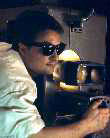|
|
This topic comprises 3 pages: 1 2 3
|
|
Author
|
Topic: Lens Types?
|
|
|
|
|
Christopher Seo
Jedi Master Film Handler

Posts: 530
From: Los Angeles, CA
Registered: Jun 99
|
 posted 06-25-2004 02:05 AM
posted 06-25-2004 02:05 AM




The term 'Scope' is derived from 'CinemaScope', which was a specific image/sound format devised by 20th Century Fox utilizing anamorphic lenses. The basic idea behind the CinemaScope image (35mm full-sized frame with 2X anamorphic) survives today. 'Anamorphic' is a generic and more formal term which could be used, I think, to describe any lens that distorts an image by magnifying it by different amounts on the vertical and horizontal axes. Nowadays, 'Scope' and 'anamorphic' are interchangeable as there is only one anamorphic format which one is likely to encounter.
A prime lens has a fixed focal length, whereas a variable prime has a small adjustment range for focal length (much less than a regular zoom lens), so the image size can be tweaked for optimum fit.
The generic term for 'Flat' is 'spherical'. Possibly, 'Flat' refers to movie screens, which were flat before the introduction of CinemaScope (which specified a curved screen). Spherical formats (1.85, 1.66, 1.37) are projected with regular prime lenses (or variable primes). Anamorphic formats are projected either with a combination of a prime lens and anamorphic adapter, or an 'integrated anamorphic' which effectively combines the two into a single tube.
| IP: Logged
|
|
|
|
|
|
|
|
|
|
Scott Norwood
Film God

Posts: 8146
From: Boston, MA. USA (1774.21 miles northeast of Dallas)
Registered: Jun 99
|
 posted 06-25-2004 07:25 AM
posted 06-25-2004 07:25 AM





1.33, 1.37, 1.66, 1.85, etc. are all "flat"--i.e. not anamorphic. Lenses don't have a concept of aspect ratio, so a 3" lens might be used for 1.85 in one theatre or 1.66 in another. The lens focal length just defines the size of the projected images, with shorter lenses providing larger images, given an equal throw distance.
Someone please correct me if I'm wrong, but my understanding is that a "variable prime" differs from a "zoom" in that the lens does not hold focus when the size adjustment is made. Thus, zoom lenses don't require a focus adjustment when zoomed, while variable prime lenses do.
| IP: Logged
|
|
|
|
Frank Angel
Film God

Posts: 5305
From: Brooklyn NY USA
Registered: Dec 1999
|
 posted 06-26-2004 06:15 PM
posted 06-26-2004 06:15 PM





Michael, I have to go with Christopher on this one -- "flat" comes from the difference that was immediately apparent to projectionists when CinemaScope was first introduced. The screens they had been projecting on up until this time were flat screens. CinemaScope screens were curved to help maintain focus and to concentrate more light back to the seating area. The depth-of-field of the lenses back then wasn't as forgiving as today's computer designed lenses. Also light was now being spread over twice the width of the non-CinemaScope screen and at this juncture getting a bright enough image was a big issue, hence the curvature of the screen. So it was natural for projectionists and industry people to refer to films that were not anamorphic, i.e., not 'Scope, to be "flat" as opposed to curved. The irony that the non-anamorphic films were now also projected on a curved screen seemed to escape them.
Of course today the curved scope screens are gone as they are considerably more expensive to install, so in a majority of theatres, scope is projected on a flat screen making the distinction a distant memory. But "flat" as the generic term to refer to any non-anamorphic, spherically projected image still remains, although it is far from very informative; as Scott has pointed out, it doesn't tell you whether it's flat 1.85, flat 1.75 (used for a while mostly by Disney), flat 1.66, flat 1.37 or flat silent 1.33! Better to just use the aspect ratio width number as the more useful nomenclature.
And as far as Deeeee-Cinema, they have a language all their own. They interchange wide screen to mean letterboxed as well as anamorphic and I have seen DVD releases that claim to be anamorphic when they actually mean letterboxed. And then there is the way they describe aspect ratios. Instead of keeping one parameter (the height) constant, i.e., "x:1," they insist on using different fractions for each, as in 16:9 and 4:3.
Someone once explained in a post that the video way is more accurate, but I can't find that post with a search and quite frankly, I don't see how those numbers are any more informative or more accurate that 2.39:1 or 1.85:1. Seems the cinema ratios directly translate whereas the video method is like comparing apples and oranges.
And it should be mentioned that anamorphic doesn't ALWAYS have to synonomus with a 2.39:1 image, as Thomas points out. There was also an elegant system proposed by Glenn Bergren of ISCO using a "mild" anamorphic and the full film frame height (as is done with CinemaScope) to produce a 1.85:1 screen image without the degredation of resolution and light output that happens with the current cropped spherical wide screen system. That idea has surfaced a number of times over the years because of its many advantages and simple implimentation. If it ever came to pass, who knows what knick-name it would be given to distinguish it from its co-existing counterparts. Perhaps, "Mild-A"....or "Non-cropped Flat"...or "Type A 1.85;" it's anyone's guess.
| IP: Logged
|
|
|
|
|
|
Frank Angel
Film God

Posts: 5305
From: Brooklyn NY USA
Registered: Dec 1999
|
 posted 06-27-2004 03:18 PM
posted 06-27-2004 03:18 PM





So it WAS you, Steve G.! I new someone pointed this out once before. But which numerical format is better to impart aspect ratio information is only a matter of perspective and preference ....you have to like whole numbers. Some of us more poetic types are perfectly happy with rounded-off numbers. Besides, let's face it, any differences three digits after the decimal point are much smaller than any amount of gross overlap that is created by the masking, and consequently this may be important in design mechanics, but irrelevant for purposes of identifying print aspect ratios.
Thing is, 16.9 and 4:3 might be nice and neat for their mathematical wholeness, but they are not any nicer or neater than 2.39 and 1.85 are for their logical unity. It's all in your mindset as to which you prefer. You have to do math (fractionsat that) in your head to visualize what 16.9 and 4:3 actually look like, whereas 2.39:1 and 1.85:1 are much more direct and apparent. Besides, I hate math.
See....techies aren't above talking metaphysics on this board!
And Steve K., yes, you can find tangental references to 3D titles being called "flat" when they were booked for 2D engagements, as in, "DIAL M FOR MURDER only played flat in it's original release," but only in passing and not as a label to distinguish one print format from the other. There was no need to identify whether or not a print was to play 3D or 2D. If you only got one set of reels, it was 2D....the projectionist didn't need too look at the reel bands for a descriptive word to know how to project it.
And I do happily concur that curved screens seem to be having a resurgence here on the East coast as well. There is nothing as pleasing to the eye a picture projected on a slightly curved screen. It imparts a kind of majestic, natural vista to the image -- at least that's what the poet might say; the mathematician would say it has a cord of a certain amount but still love it for its perfection in exactly matching the lens focal points along the curve.
Some of the new builds here have installed curves, yet there are still quite a few new theatres that still retain the flat screen, mostly because they are smaller rooms. I guess if you've got a 15 foot screen, the curve wouldn't be significant enough to impart much of anything.
But you must admit, for decades once the conversion to multiplex was in full swing, curved screens simply disappeared (along with curtains and even movable masking). I would hazard a guess that there are still many more flat screens to curved in NY, probably in a ratio of maybe 7:1....but of course this ratio is only a guestimate and not whole numbers. ![[Big Grin]](biggrin.gif)
[ 06-28-2004, 12:29 PM: Message edited by: Frank Angel ]
| IP: Logged
|
|
|
|
|
|
|
|
All times are Central (GMT -6:00)
|
This topic comprises 3 pages: 1 2 3
|
Powered by Infopop Corporation
UBB.classicTM
6.3.1.2
The Film-Tech Forums are designed for various members related to the cinema industry to express their opinions, viewpoints and testimonials on various products, services and events based upon speculation, personal knowledge and factual information through use, therefore all views represented here allow no liability upon the publishers of this web site and the owners of said views assume no liability for any ill will resulting from these postings. The posts made here are for educational as well as entertainment purposes and as such anyone viewing this portion of the website must accept these views as statements of the author of that opinion
and agrees to release the authors from any and all liability.
|

 Home
Home
 Products
Products
 Store
Store
 Forum
Forum
 Warehouse
Warehouse
 Contact Us
Contact Us




 Printer-friendly view of this topic
Printer-friendly view of this topic







![[beer]](graemlins/beer.gif)







![[Big Grin]](biggrin.gif)




